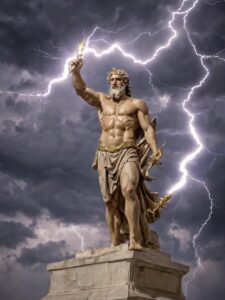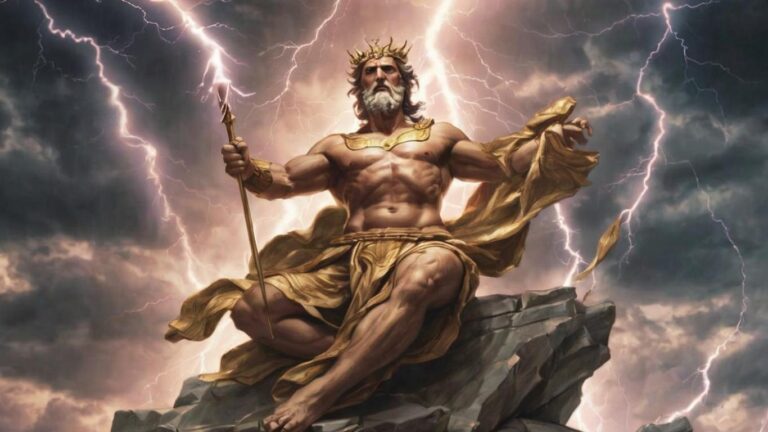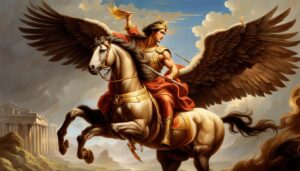Table of Contents
Zeus, the paramount deity in Greek mythology, reigns as the king of the Olympian gods. A mature and bearded figure, He symbolizes authority, wisdom, and divine power. Adorned in flowing robes and a regal crown, he wields a thunderbolt, emblematic of his dominion over lightning and thunder. Often accompanied by an eagle, Zeus commands the heavens from Mount Olympus, the divine realm. Beyond his iconic appearance, KIng of the Gods possesses a myriad of powers, including shape-shifting, omnipresence, and control over weather. His immortal stature and superhuman strength underscore his role as a principal figure in Greek mythology, presiding over justice, order, and the pantheon of gods. The narratives surrounding Zeus depict a complex and influential deity, shaping the mythological landscape with his role in the Titanomachy and the creation of mortals.
Origins
The birth of Zeus and the subsequent events, including the Titanomachy, involve a sequence of events in Greek mythology.
Cronus, fearing a prophecy that one of his children would overthrow him, swallowed each of his offspring as they were born. This included Hestia, Hera, Demeter, Poseidon, and Hades.
When Rhea gave birth to Zeus, she presented Cronus with a stone wrapped in swaddling clothes, and Cronus swallowed it, thinking it was Zeus. Rhea then hid Zeus on the island of Crete.
Zeus was raised in secret on Crete, and during his upbringing, he was protected by the nymphs Adamanthea and Melissa.
When Zeus reached adulthood, he confronted Cronus and the Titans. With the help of his siblings (Hestia, Hera, Demeter, Poseidon, and Hades), Zeus led a rebellion against Cronus and the Titans.
The Titanomachy was the resulting battle between the Olympian gods, led by Zeus, and the Titans. The younger generation of gods, including Poseidon and Hades, joined Zeus in this conflict.
So, to clarify, Poseidon and Hades were born before Zeus, but they were among the siblings whom Cronus had swallowed. They were later released when Zeus confronted Cronus and forced him to regurgitate his siblings. The three brothers, Zeus, Poseidon, and Hades, then played crucial roles in the overthrow of the Titans and the establishment of the Olympian order.
Appearance

Zeus, a mature and bearded deity, exudes authority and wisdom, his beard signifying experience. Adorned in flowing robes and a divine crown, he stands as the god-king in artistic depictions. His iconic weapon, the thunderbolt, symbolizes his command over thunder and lightning, epitomizing power. The eagle, Zeus’s sacred companion, often perches on his shoulder, accentuating his divine presence.
A scepter, held in some portrayals, underscores Zeus’s absolute authority and rulership. Whether seated on Mount Olympus or atop a divine throne, King of the Gods commands the highest peak in Greece. It’s crucial to recognize the variability in artistic representations, allowing for flexibility and regional influences in capturing Zeus’s essence. Different epochs and regions contribute to diverse depictions of this regal god.
Powers:
As the supreme deity and king of the gods, Zeus wielded a diverse range of powers. Controlling lightning and thunder, Zeus hurled bolts as formidable weapons, instigating thunderstorms. His prowess extended to shape-shifting, allowing him to assume various disguises for divine interactions. Immortal like his divine counterparts, Zeus defied aging and mortality. His superhuman strength ranked him among the mightiest in the Greek pantheon. Zeus’s influence, though not omnipresent, spanned a vast sphere, observing events globally from Mount Olympus.
In addition to his thunderous might, Zeus possessed mastery over the skies, capable of weather manipulation. Presiding over justice, Zeus served as the ultimate arbiter among gods, upholding divine law and order. He navigated the heavens through effortless flight, traversing great distances swiftly. Linked to the fertility of the earth, Zeus oversaw the growth of crops and ensured abundance.
Ruling Mount Olympus, Zeus commanded the divine realm from its lofty heights. Engaging in the creation of mortals, he played a pivotal role in humanity’s genesis. Zeus’s powers, woven into the fabric of Greek mythology, rendered him a formidable and influential figure, shaping the narratives of countless myths and legends.
Symbols
Family
The major siblings of Zeus include:
Hestia: Hestia is the goddess of the hearth, home, and family. She was the eldest sibling and, in some traditions, gave up her seat among the Olympian gods to Dionysus.
Hera: Hera is the queen of the Olympian gods and the goddess of marriage, family, and childbirth. She became Zeus’s wife and was considered one of the principal deities on Mount Olympus.
Demeter: Demeter is the goddess of agriculture, fertility, and the harvest. She played a significant role in the cycle of the seasons.
Poseidon: Poseidon is the god of the sea, earthquakes, and horses. He is one of the three powerful brothers who divided the realms of the world among themselves.
Hades: Hades is the god of the underworld and the ruler of the dead. Like Poseidon, he is one of the three brothers who govern different realms.
Wives

Zeus’s main wife, Hera, reigned as queen of the Olympian gods, overseeing marriage and childbirth. Despite familial ties, Zeus and Hera, married, a common divine theme. Among Zeus’s other consorts: Metis, Themis, Eurynome, Demeter, Leto, Io, Dione, and Maia. These unions reveal the intricate tapestry of divine relationships in Greek mythology.
Zeus was indeed known for his many love affairs, resulting in numerous offspring. Here are some of Zeus’s notable children, along with brief descriptions of how he met their mothers:
Children of Zeus and Mortal Women:
Perseus:
- Mother: Danaë
- Story: Zeus transformed into a shower of golden rain to enter the locked chamber of Danaë, resulting in the birth of Perseus. Perseus later became a hero, known for slaying the Gorgon Medusa.
Epaphus:
- Mother: Io
- Story: Zeus transformed Io into a cow to protect her from Hera’s jealousy. Despite the transformation, Hera sent a gadfly to torment Io, who eventually gave birth to Epaphus.
Tantalus:
- Mother: Pluto
- Story: Tantalus was a mortal son of Zeus or Pluto. He faced divine punishment for various transgressions, including attempting to feed his own son to the gods.
Children of Zeus with Deities:
Zeus Dauthers:
Athena. Metis was a Titaness and the goddess of wisdom. Zeus swallowed Metis while she was pregnant, fearing a prophecy that her child would overthrow him. Athena later emerged fully grown from Zeus’s forehead.
Helen of Troy. Zeus transformed into a swan to seduce Leda, resulting in the birth of Helen, who became a central figure in the Trojan War.
Hermes. Maia, a nymph and one of the Pleiades, caught Zeus’s attention. Hermes, the messenger of the gods, was born from their union.
Aphrodite. Origin varies; one version involves Zeus and Dione, while another suggests she arose from the sea foam after Cronus’s severed genitals were cast into the ocean.
Hebe. Hebe, the goddess of youth, was the daughter of Zeus and Hera. She served as the cupbearer to the gods on Mount Olympus.
Britomartis. Britomartis was a Cretan goddess associated with hunting and fishing. According to some accounts, Zeus was involved in her birth.
Pandora. Pandora was the first woman on Earth. Zeus, angered by Prometheus’s actions, sent Pandora as a punishment. She opened a jar (often mistranslated as “box”) containing all the evils of the world.
Zeus Sons:
Dionysus. Zeus fell in love with the mortal Semele. Hera, in disguise, convinced Semele to ask lover to reveal himself in his true form. The intense radiance of Zeus’s true form incinerated Semele, but Zeus saved their unborn child, Dionysus.
Hephaestus. In one version, Hephaestus, the god of craftsmanship, was born solely from Hera without the involvement of Zeus. This birth was an attempt by Hera to prove that she could produce offspring without a male partner.
Ares. Ares, the god of war, was conceived through the union of Zeus and his wife Hera. Despite being the son of both king and queen of the gods, Ares was not a universally beloved figure in Greek mythology.
Dardanus. Dardanus was a founder of the city of Troy. According to some accounts, Zeus had a union with the Pleiad Electra, resulting in the birth of Dardanus.
Aegipan. Aegipan, a god with the lower body of a goat and the upper body of a fish, was sometimes considered the son of Zeus and Aex, a goat-nymph.
Apollo and Artemis. Leto, a Titaness, was pursued by Zeus and became pregnant with twins. Hera, out of jealousy, made it difficult for Leto to find a place to give birth. Delos, a floating island, finally provided a refuge, and Apollo and Artemis were born.
Hercules (Heracles). Zeus disguised himself as Alcmena’s husband, Amphitryon, and impregnated her. Hercules, known for his incredible strength, was the result of this union.
Persephone. Zeus allowed Hades to marry Persephone without informing Demeter. The abduction of Persephone led to the creation of the seasons, as Demeter mourned her daughter’s absence.
FAQ
Who is Zeus?
Zeus is a major deity in Greek mythology, the ruler of Mount Olympus, and the supreme god in the Greek pantheon.
Who is Zeus's father?
Zeus's father is Cronus, one of the Titans in Greek mythology.
Who is Zeus's wife?
Zeus's wife is Hera, who is also his sister.
How many children did Zeus have?
Zeus had many children, with various gods, goddesses, and mortal women. The exact number varies in different myths, but some well-known offspring include Athena, Apollo, Artemis, Hermes, Persephone, and Hercules.
Who killed Zeus?
In classical Greek mythology, Zeus is not killed; he is considered immortal and the most powerful god.
How tall is Zeus?
In mythology, gods' physical characteristics, including height, are not precisely defined. Descriptions of Zeus often emphasize his regal and powerful presence rather than specific measurements.
What is Zeus's symbol?
Zeus is commonly associated with the thunderbolt as his symbol. The eagle, bull, and oak tree are also significant symbols linked to him.
What is Zeus's Roman name?
In Roman mythology, Zeus is equivalent to the god Jupiter.
Who is Zeus's mother?
Zeus's mother is Rhea, one of the Titans and the sister and wife of Cronus.
What happened to the statue of Zeus?
The Statue of Zeus at Olympia was one of the Seven Wonders of the Ancient World. It was eventually destroyed, likely during the 5th century AD, although the exact details are unclear.
What were Zeus's powers?
Zeus had control over the weather, particularly lightning and thunder. He was also considered the ruler of the gods, with authority over Mount Olympus and the affairs of both gods and mortals.




